Analysis of Business Demography in the New South Wales State
VerifiedAdded on 2022/09/18
|8
|2202
|25
Report
AI Summary
This report provides a detailed analysis of business demography in New South Wales, examining population growth, trends, and their impact on the business environment. It explores key components of population change, including natural increase, net overseas migration, and net interstate migration, and how these factors influence economic characteristics. The report also investigates the demographic impacts on the business environment, such as population and age distribution, regional economic diversity, and employment and income patterns. Furthermore, it discusses the decentralization of existing services and businesses, government policies encouraging migration, and the challenges associated with these initiatives. The analysis includes data from the Australian Bureau of Statistics and various research papers, offering insights into the economic disparities, industry trends, and policy implications for the state's business landscape.
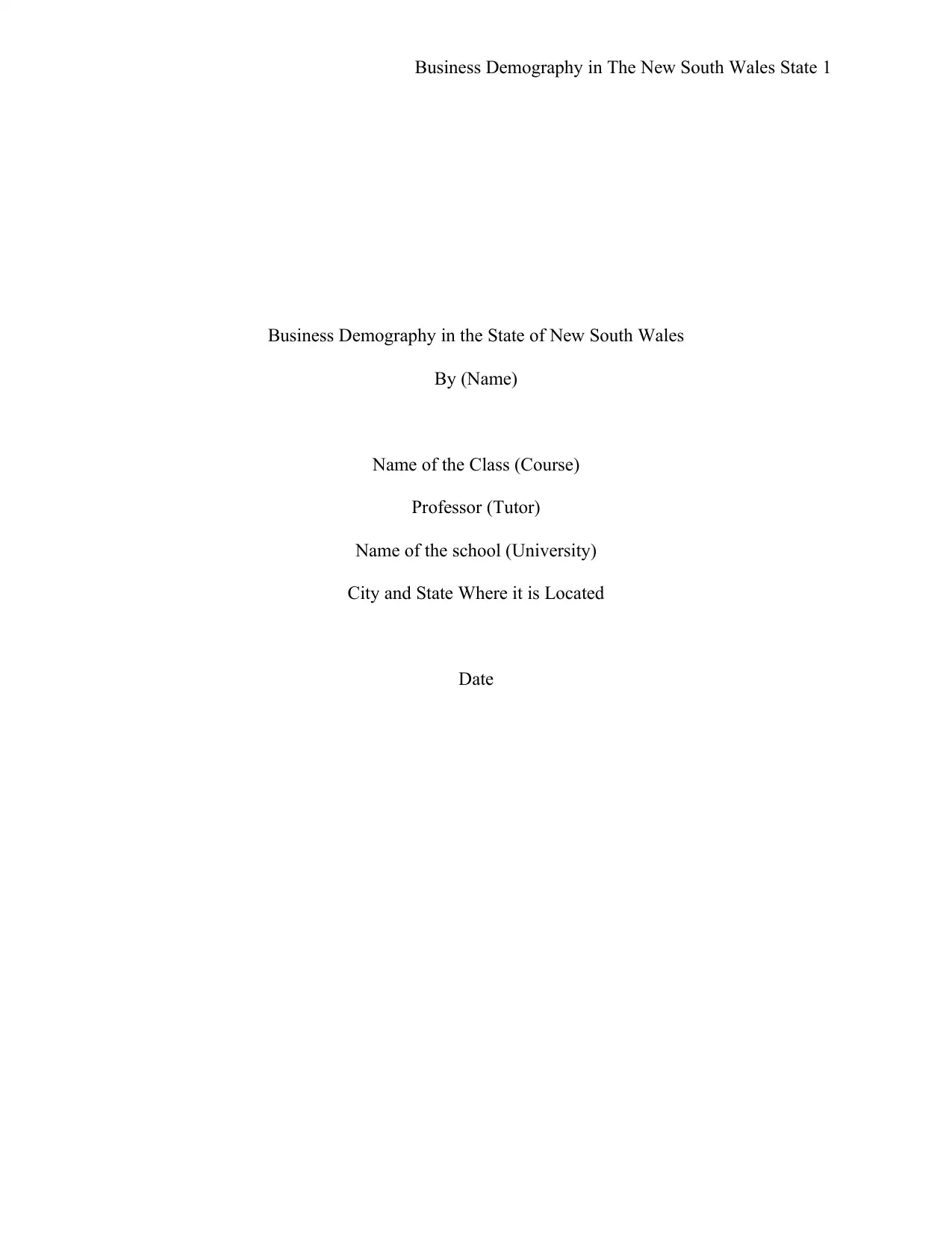
Business Demography in The New South Wales State 1
Business Demography in the State of New South Wales
By (Name)
Name of the Class (Course)
Professor (Tutor)
Name of the school (University)
City and State Where it is Located
Date
Business Demography in the State of New South Wales
By (Name)
Name of the Class (Course)
Professor (Tutor)
Name of the school (University)
City and State Where it is Located
Date
Paraphrase This Document
Need a fresh take? Get an instant paraphrase of this document with our AI Paraphraser
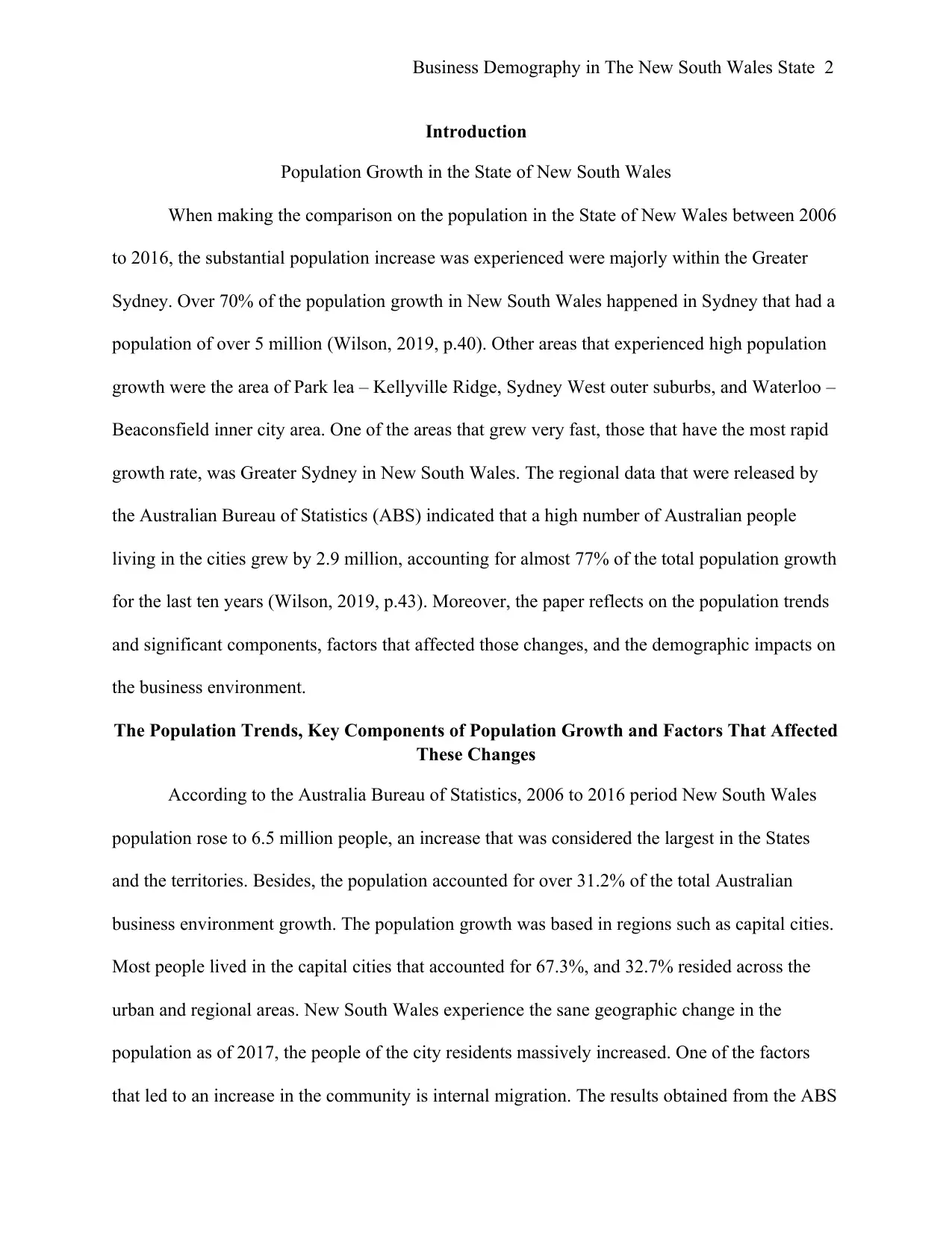
Business Demography in The New South Wales State 2
Introduction
Population Growth in the State of New South Wales
When making the comparison on the population in the State of New Wales between 2006
to 2016, the substantial population increase was experienced were majorly within the Greater
Sydney. Over 70% of the population growth in New South Wales happened in Sydney that had a
population of over 5 million (Wilson, 2019, p.40). Other areas that experienced high population
growth were the area of Park lea – Kellyville Ridge, Sydney West outer suburbs, and Waterloo –
Beaconsfield inner city area. One of the areas that grew very fast, those that have the most rapid
growth rate, was Greater Sydney in New South Wales. The regional data that were released by
the Australian Bureau of Statistics (ABS) indicated that a high number of Australian people
living in the cities grew by 2.9 million, accounting for almost 77% of the total population growth
for the last ten years (Wilson, 2019, p.43). Moreover, the paper reflects on the population trends
and significant components, factors that affected those changes, and the demographic impacts on
the business environment.
The Population Trends, Key Components of Population Growth and Factors That Affected
These Changes
According to the Australia Bureau of Statistics, 2006 to 2016 period New South Wales
population rose to 6.5 million people, an increase that was considered the largest in the States
and the territories. Besides, the population accounted for over 31.2% of the total Australian
business environment growth. The population growth was based in regions such as capital cities.
Most people lived in the capital cities that accounted for 67.3%, and 32.7% resided across the
urban and regional areas. New South Wales experience the sane geographic change in the
population as of 2017, the people of the city residents massively increased. One of the factors
that led to an increase in the community is internal migration. The results obtained from the ABS
Introduction
Population Growth in the State of New South Wales
When making the comparison on the population in the State of New Wales between 2006
to 2016, the substantial population increase was experienced were majorly within the Greater
Sydney. Over 70% of the population growth in New South Wales happened in Sydney that had a
population of over 5 million (Wilson, 2019, p.40). Other areas that experienced high population
growth were the area of Park lea – Kellyville Ridge, Sydney West outer suburbs, and Waterloo –
Beaconsfield inner city area. One of the areas that grew very fast, those that have the most rapid
growth rate, was Greater Sydney in New South Wales. The regional data that were released by
the Australian Bureau of Statistics (ABS) indicated that a high number of Australian people
living in the cities grew by 2.9 million, accounting for almost 77% of the total population growth
for the last ten years (Wilson, 2019, p.43). Moreover, the paper reflects on the population trends
and significant components, factors that affected those changes, and the demographic impacts on
the business environment.
The Population Trends, Key Components of Population Growth and Factors That Affected
These Changes
According to the Australia Bureau of Statistics, 2006 to 2016 period New South Wales
population rose to 6.5 million people, an increase that was considered the largest in the States
and the territories. Besides, the population accounted for over 31.2% of the total Australian
business environment growth. The population growth was based in regions such as capital cities.
Most people lived in the capital cities that accounted for 67.3%, and 32.7% resided across the
urban and regional areas. New South Wales experience the sane geographic change in the
population as of 2017, the people of the city residents massively increased. One of the factors
that led to an increase in the community is internal migration. The results obtained from the ABS
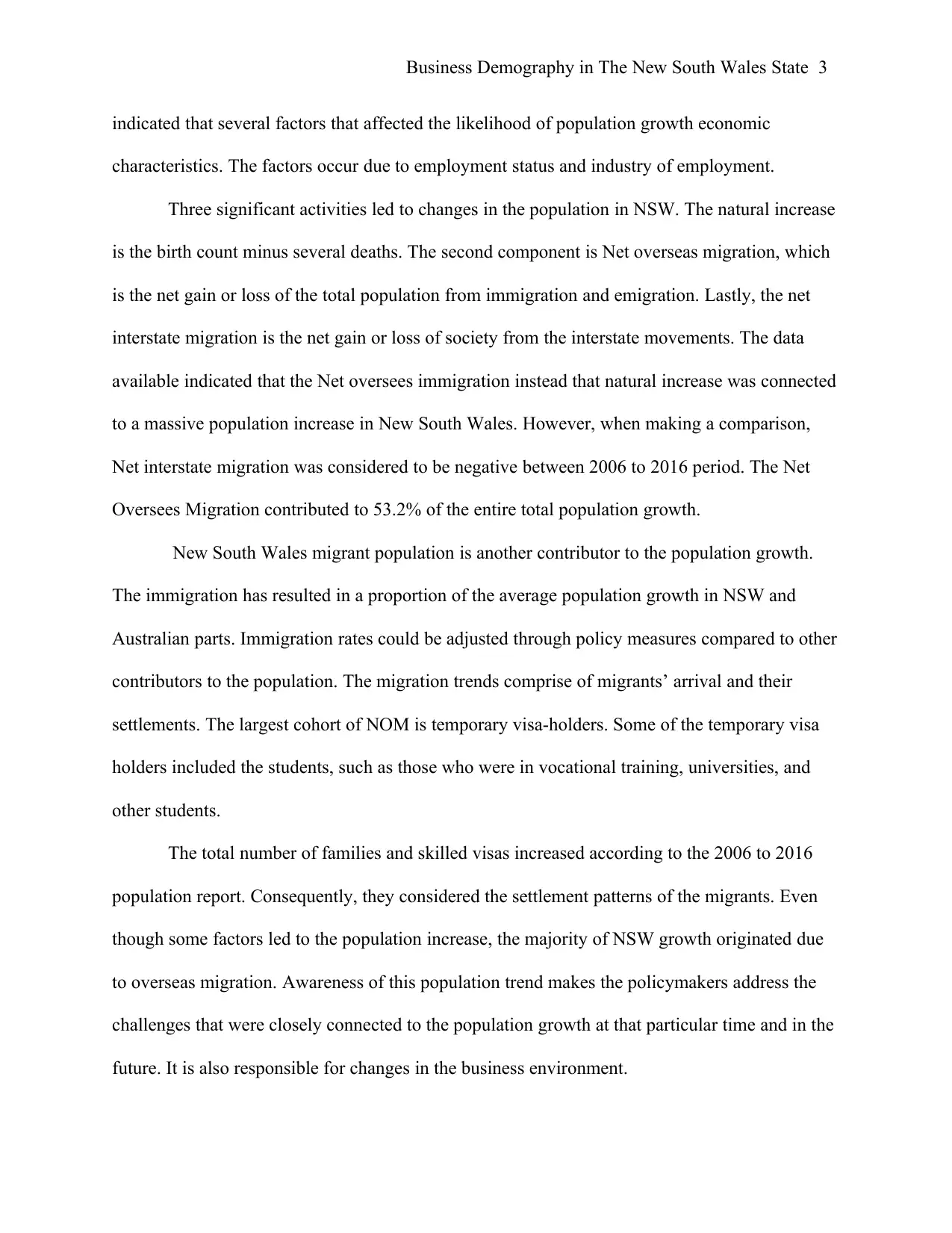
Business Demography in The New South Wales State 3
indicated that several factors that affected the likelihood of population growth economic
characteristics. The factors occur due to employment status and industry of employment.
Three significant activities led to changes in the population in NSW. The natural increase
is the birth count minus several deaths. The second component is Net overseas migration, which
is the net gain or loss of the total population from immigration and emigration. Lastly, the net
interstate migration is the net gain or loss of society from the interstate movements. The data
available indicated that the Net oversees immigration instead that natural increase was connected
to a massive population increase in New South Wales. However, when making a comparison,
Net interstate migration was considered to be negative between 2006 to 2016 period. The Net
Oversees Migration contributed to 53.2% of the entire total population growth.
New South Wales migrant population is another contributor to the population growth.
The immigration has resulted in a proportion of the average population growth in NSW and
Australian parts. Immigration rates could be adjusted through policy measures compared to other
contributors to the population. The migration trends comprise of migrants’ arrival and their
settlements. The largest cohort of NOM is temporary visa-holders. Some of the temporary visa
holders included the students, such as those who were in vocational training, universities, and
other students.
The total number of families and skilled visas increased according to the 2006 to 2016
population report. Consequently, they considered the settlement patterns of the migrants. Even
though some factors led to the population increase, the majority of NSW growth originated due
to overseas migration. Awareness of this population trend makes the policymakers address the
challenges that were closely connected to the population growth at that particular time and in the
future. It is also responsible for changes in the business environment.
indicated that several factors that affected the likelihood of population growth economic
characteristics. The factors occur due to employment status and industry of employment.
Three significant activities led to changes in the population in NSW. The natural increase
is the birth count minus several deaths. The second component is Net overseas migration, which
is the net gain or loss of the total population from immigration and emigration. Lastly, the net
interstate migration is the net gain or loss of society from the interstate movements. The data
available indicated that the Net oversees immigration instead that natural increase was connected
to a massive population increase in New South Wales. However, when making a comparison,
Net interstate migration was considered to be negative between 2006 to 2016 period. The Net
Oversees Migration contributed to 53.2% of the entire total population growth.
New South Wales migrant population is another contributor to the population growth.
The immigration has resulted in a proportion of the average population growth in NSW and
Australian parts. Immigration rates could be adjusted through policy measures compared to other
contributors to the population. The migration trends comprise of migrants’ arrival and their
settlements. The largest cohort of NOM is temporary visa-holders. Some of the temporary visa
holders included the students, such as those who were in vocational training, universities, and
other students.
The total number of families and skilled visas increased according to the 2006 to 2016
population report. Consequently, they considered the settlement patterns of the migrants. Even
though some factors led to the population increase, the majority of NSW growth originated due
to overseas migration. Awareness of this population trend makes the policymakers address the
challenges that were closely connected to the population growth at that particular time and in the
future. It is also responsible for changes in the business environment.
⊘ This is a preview!⊘
Do you want full access?
Subscribe today to unlock all pages.

Trusted by 1+ million students worldwide
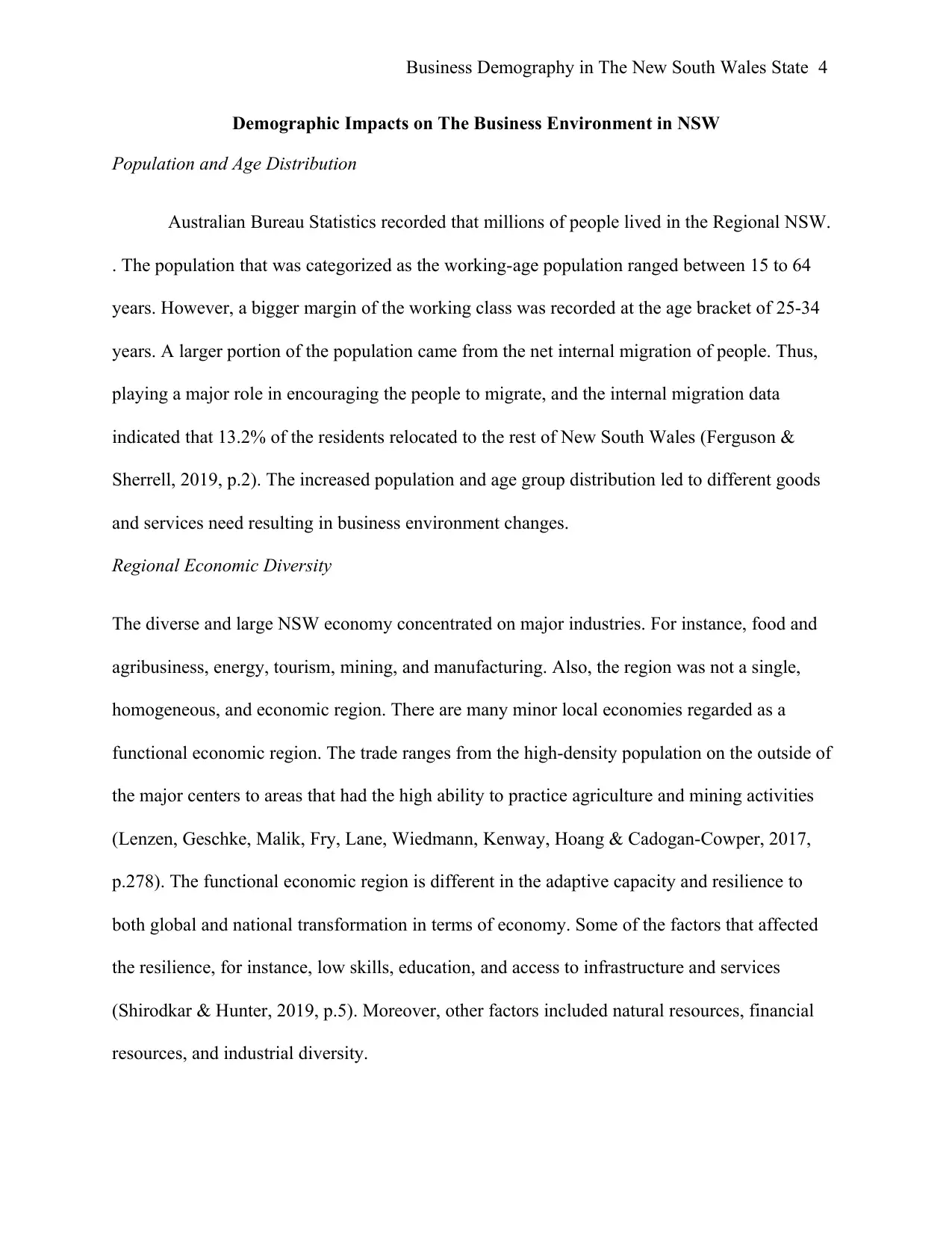
Business Demography in The New South Wales State 4
Demographic Impacts on The Business Environment in NSW
Population and Age Distribution
Australian Bureau Statistics recorded that millions of people lived in the Regional NSW.
. The population that was categorized as the working-age population ranged between 15 to 64
years. However, a bigger margin of the working class was recorded at the age bracket of 25-34
years. A larger portion of the population came from the net internal migration of people. Thus,
playing a major role in encouraging the people to migrate, and the internal migration data
indicated that 13.2% of the residents relocated to the rest of New South Wales (Ferguson &
Sherrell, 2019, p.2). The increased population and age group distribution led to different goods
and services need resulting in business environment changes.
Regional Economic Diversity
The diverse and large NSW economy concentrated on major industries. For instance, food and
agribusiness, energy, tourism, mining, and manufacturing. Also, the region was not a single,
homogeneous, and economic region. There are many minor local economies regarded as a
functional economic region. The trade ranges from the high-density population on the outside of
the major centers to areas that had the high ability to practice agriculture and mining activities
(Lenzen, Geschke, Malik, Fry, Lane, Wiedmann, Kenway, Hoang & Cadogan-Cowper, 2017,
p.278). The functional economic region is different in the adaptive capacity and resilience to
both global and national transformation in terms of economy. Some of the factors that affected
the resilience, for instance, low skills, education, and access to infrastructure and services
(Shirodkar & Hunter, 2019, p.5). Moreover, other factors included natural resources, financial
resources, and industrial diversity.
Demographic Impacts on The Business Environment in NSW
Population and Age Distribution
Australian Bureau Statistics recorded that millions of people lived in the Regional NSW.
. The population that was categorized as the working-age population ranged between 15 to 64
years. However, a bigger margin of the working class was recorded at the age bracket of 25-34
years. A larger portion of the population came from the net internal migration of people. Thus,
playing a major role in encouraging the people to migrate, and the internal migration data
indicated that 13.2% of the residents relocated to the rest of New South Wales (Ferguson &
Sherrell, 2019, p.2). The increased population and age group distribution led to different goods
and services need resulting in business environment changes.
Regional Economic Diversity
The diverse and large NSW economy concentrated on major industries. For instance, food and
agribusiness, energy, tourism, mining, and manufacturing. Also, the region was not a single,
homogeneous, and economic region. There are many minor local economies regarded as a
functional economic region. The trade ranges from the high-density population on the outside of
the major centers to areas that had the high ability to practice agriculture and mining activities
(Lenzen, Geschke, Malik, Fry, Lane, Wiedmann, Kenway, Hoang & Cadogan-Cowper, 2017,
p.278). The functional economic region is different in the adaptive capacity and resilience to
both global and national transformation in terms of economy. Some of the factors that affected
the resilience, for instance, low skills, education, and access to infrastructure and services
(Shirodkar & Hunter, 2019, p.5). Moreover, other factors included natural resources, financial
resources, and industrial diversity.
Paraphrase This Document
Need a fresh take? Get an instant paraphrase of this document with our AI Paraphraser
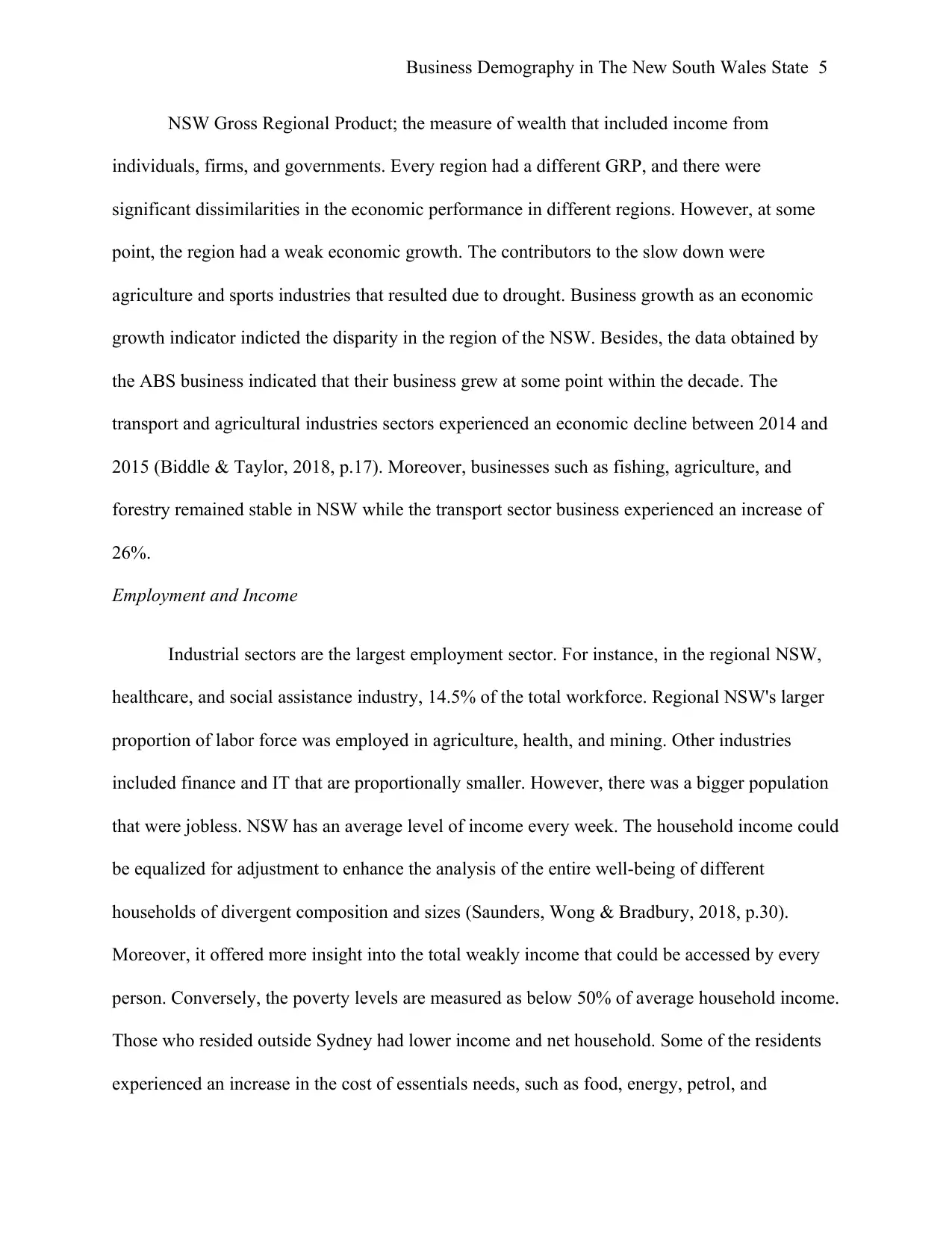
Business Demography in The New South Wales State 5
NSW Gross Regional Product; the measure of wealth that included income from
individuals, firms, and governments. Every region had a different GRP, and there were
significant dissimilarities in the economic performance in different regions. However, at some
point, the region had a weak economic growth. The contributors to the slow down were
agriculture and sports industries that resulted due to drought. Business growth as an economic
growth indicator indicted the disparity in the region of the NSW. Besides, the data obtained by
the ABS business indicated that their business grew at some point within the decade. The
transport and agricultural industries sectors experienced an economic decline between 2014 and
2015 (Biddle & Taylor, 2018, p.17). Moreover, businesses such as fishing, agriculture, and
forestry remained stable in NSW while the transport sector business experienced an increase of
26%.
Employment and Income
Industrial sectors are the largest employment sector. For instance, in the regional NSW,
healthcare, and social assistance industry, 14.5% of the total workforce. Regional NSW's larger
proportion of labor force was employed in agriculture, health, and mining. Other industries
included finance and IT that are proportionally smaller. However, there was a bigger population
that were jobless. NSW has an average level of income every week. The household income could
be equalized for adjustment to enhance the analysis of the entire well-being of different
households of divergent composition and sizes (Saunders, Wong & Bradbury, 2018, p.30).
Moreover, it offered more insight into the total weakly income that could be accessed by every
person. Conversely, the poverty levels are measured as below 50% of average household income.
Those who resided outside Sydney had lower income and net household. Some of the residents
experienced an increase in the cost of essentials needs, such as food, energy, petrol, and
NSW Gross Regional Product; the measure of wealth that included income from
individuals, firms, and governments. Every region had a different GRP, and there were
significant dissimilarities in the economic performance in different regions. However, at some
point, the region had a weak economic growth. The contributors to the slow down were
agriculture and sports industries that resulted due to drought. Business growth as an economic
growth indicator indicted the disparity in the region of the NSW. Besides, the data obtained by
the ABS business indicated that their business grew at some point within the decade. The
transport and agricultural industries sectors experienced an economic decline between 2014 and
2015 (Biddle & Taylor, 2018, p.17). Moreover, businesses such as fishing, agriculture, and
forestry remained stable in NSW while the transport sector business experienced an increase of
26%.
Employment and Income
Industrial sectors are the largest employment sector. For instance, in the regional NSW,
healthcare, and social assistance industry, 14.5% of the total workforce. Regional NSW's larger
proportion of labor force was employed in agriculture, health, and mining. Other industries
included finance and IT that are proportionally smaller. However, there was a bigger population
that were jobless. NSW has an average level of income every week. The household income could
be equalized for adjustment to enhance the analysis of the entire well-being of different
households of divergent composition and sizes (Saunders, Wong & Bradbury, 2018, p.30).
Moreover, it offered more insight into the total weakly income that could be accessed by every
person. Conversely, the poverty levels are measured as below 50% of average household income.
Those who resided outside Sydney had lower income and net household. Some of the residents
experienced an increase in the cost of essentials needs, such as food, energy, petrol, and
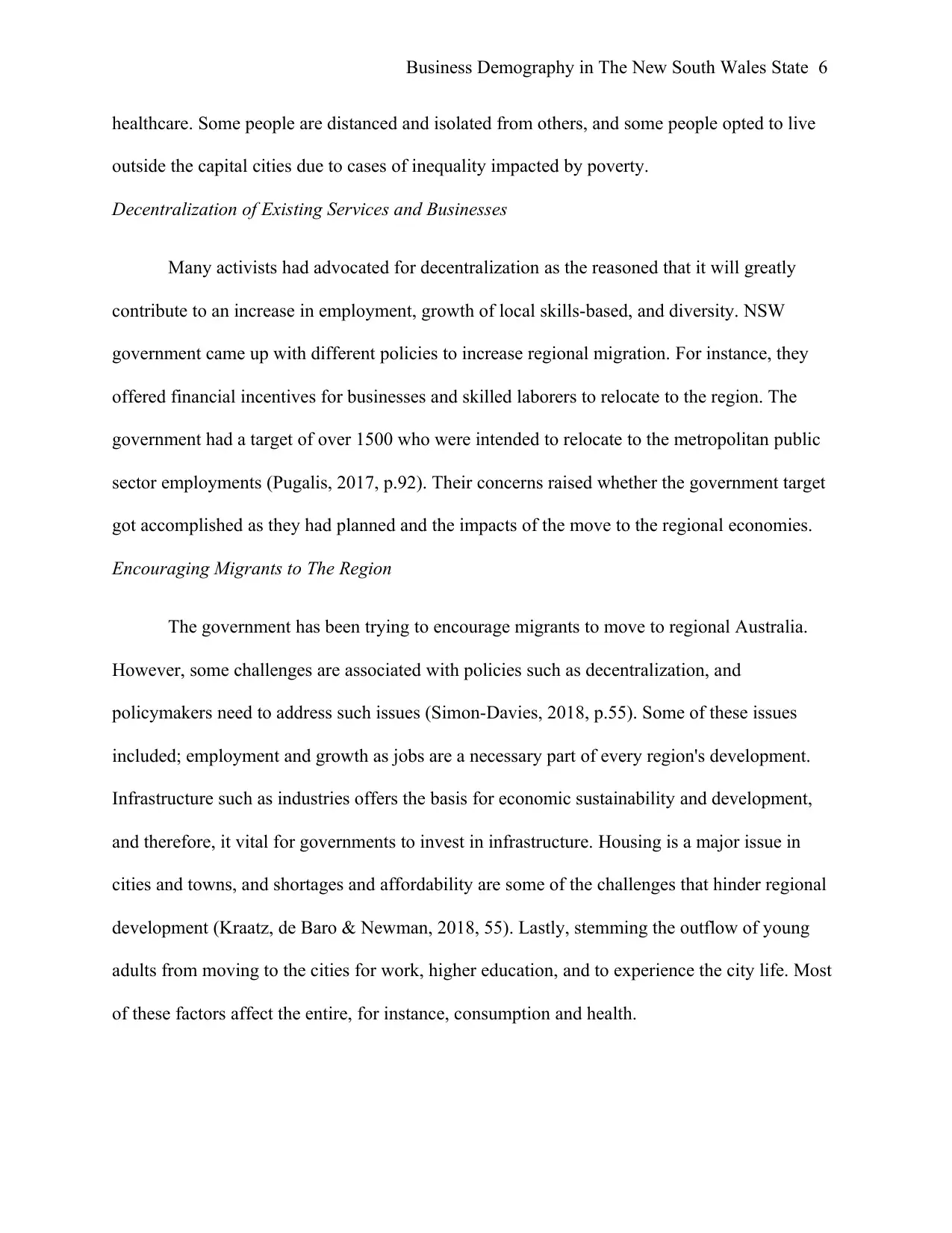
Business Demography in The New South Wales State 6
healthcare. Some people are distanced and isolated from others, and some people opted to live
outside the capital cities due to cases of inequality impacted by poverty.
Decentralization of Existing Services and Businesses
Many activists had advocated for decentralization as the reasoned that it will greatly
contribute to an increase in employment, growth of local skills-based, and diversity. NSW
government came up with different policies to increase regional migration. For instance, they
offered financial incentives for businesses and skilled laborers to relocate to the region. The
government had a target of over 1500 who were intended to relocate to the metropolitan public
sector employments (Pugalis, 2017, p.92). Their concerns raised whether the government target
got accomplished as they had planned and the impacts of the move to the regional economies.
Encouraging Migrants to The Region
The government has been trying to encourage migrants to move to regional Australia.
However, some challenges are associated with policies such as decentralization, and
policymakers need to address such issues (Simon-Davies, 2018, p.55). Some of these issues
included; employment and growth as jobs are a necessary part of every region's development.
Infrastructure such as industries offers the basis for economic sustainability and development,
and therefore, it vital for governments to invest in infrastructure. Housing is a major issue in
cities and towns, and shortages and affordability are some of the challenges that hinder regional
development (Kraatz, de Baro & Newman, 2018, 55). Lastly, stemming the outflow of young
adults from moving to the cities for work, higher education, and to experience the city life. Most
of these factors affect the entire, for instance, consumption and health.
healthcare. Some people are distanced and isolated from others, and some people opted to live
outside the capital cities due to cases of inequality impacted by poverty.
Decentralization of Existing Services and Businesses
Many activists had advocated for decentralization as the reasoned that it will greatly
contribute to an increase in employment, growth of local skills-based, and diversity. NSW
government came up with different policies to increase regional migration. For instance, they
offered financial incentives for businesses and skilled laborers to relocate to the region. The
government had a target of over 1500 who were intended to relocate to the metropolitan public
sector employments (Pugalis, 2017, p.92). Their concerns raised whether the government target
got accomplished as they had planned and the impacts of the move to the regional economies.
Encouraging Migrants to The Region
The government has been trying to encourage migrants to move to regional Australia.
However, some challenges are associated with policies such as decentralization, and
policymakers need to address such issues (Simon-Davies, 2018, p.55). Some of these issues
included; employment and growth as jobs are a necessary part of every region's development.
Infrastructure such as industries offers the basis for economic sustainability and development,
and therefore, it vital for governments to invest in infrastructure. Housing is a major issue in
cities and towns, and shortages and affordability are some of the challenges that hinder regional
development (Kraatz, de Baro & Newman, 2018, 55). Lastly, stemming the outflow of young
adults from moving to the cities for work, higher education, and to experience the city life. Most
of these factors affect the entire, for instance, consumption and health.
⊘ This is a preview!⊘
Do you want full access?
Subscribe today to unlock all pages.

Trusted by 1+ million students worldwide
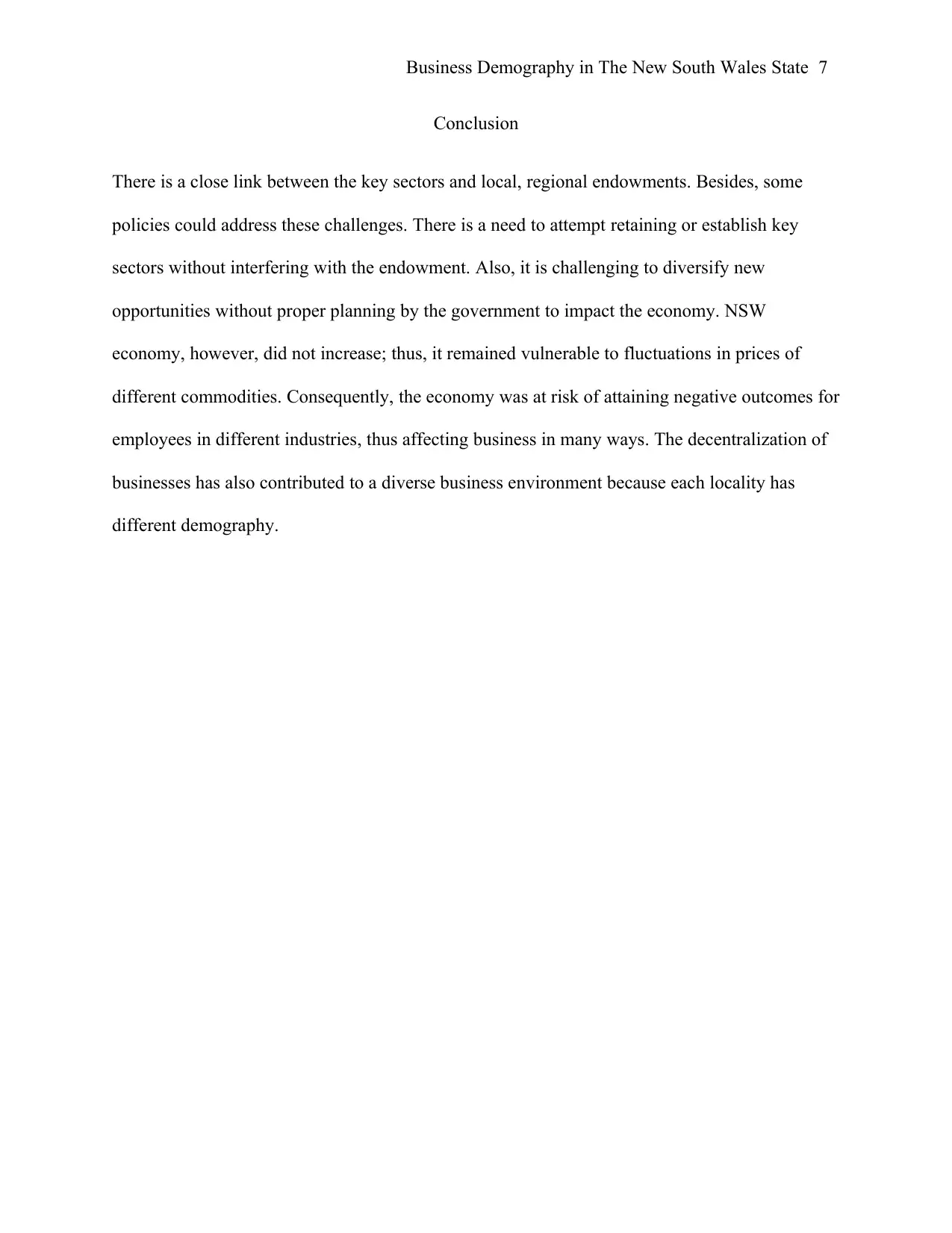
Business Demography in The New South Wales State 7
Conclusion
There is a close link between the key sectors and local, regional endowments. Besides, some
policies could address these challenges. There is a need to attempt retaining or establish key
sectors without interfering with the endowment. Also, it is challenging to diversify new
opportunities without proper planning by the government to impact the economy. NSW
economy, however, did not increase; thus, it remained vulnerable to fluctuations in prices of
different commodities. Consequently, the economy was at risk of attaining negative outcomes for
employees in different industries, thus affecting business in many ways. The decentralization of
businesses has also contributed to a diverse business environment because each locality has
different demography.
Conclusion
There is a close link between the key sectors and local, regional endowments. Besides, some
policies could address these challenges. There is a need to attempt retaining or establish key
sectors without interfering with the endowment. Also, it is challenging to diversify new
opportunities without proper planning by the government to impact the economy. NSW
economy, however, did not increase; thus, it remained vulnerable to fluctuations in prices of
different commodities. Consequently, the economy was at risk of attaining negative outcomes for
employees in different industries, thus affecting business in many ways. The decentralization of
businesses has also contributed to a diverse business environment because each locality has
different demography.
Paraphrase This Document
Need a fresh take? Get an instant paraphrase of this document with our AI Paraphraser
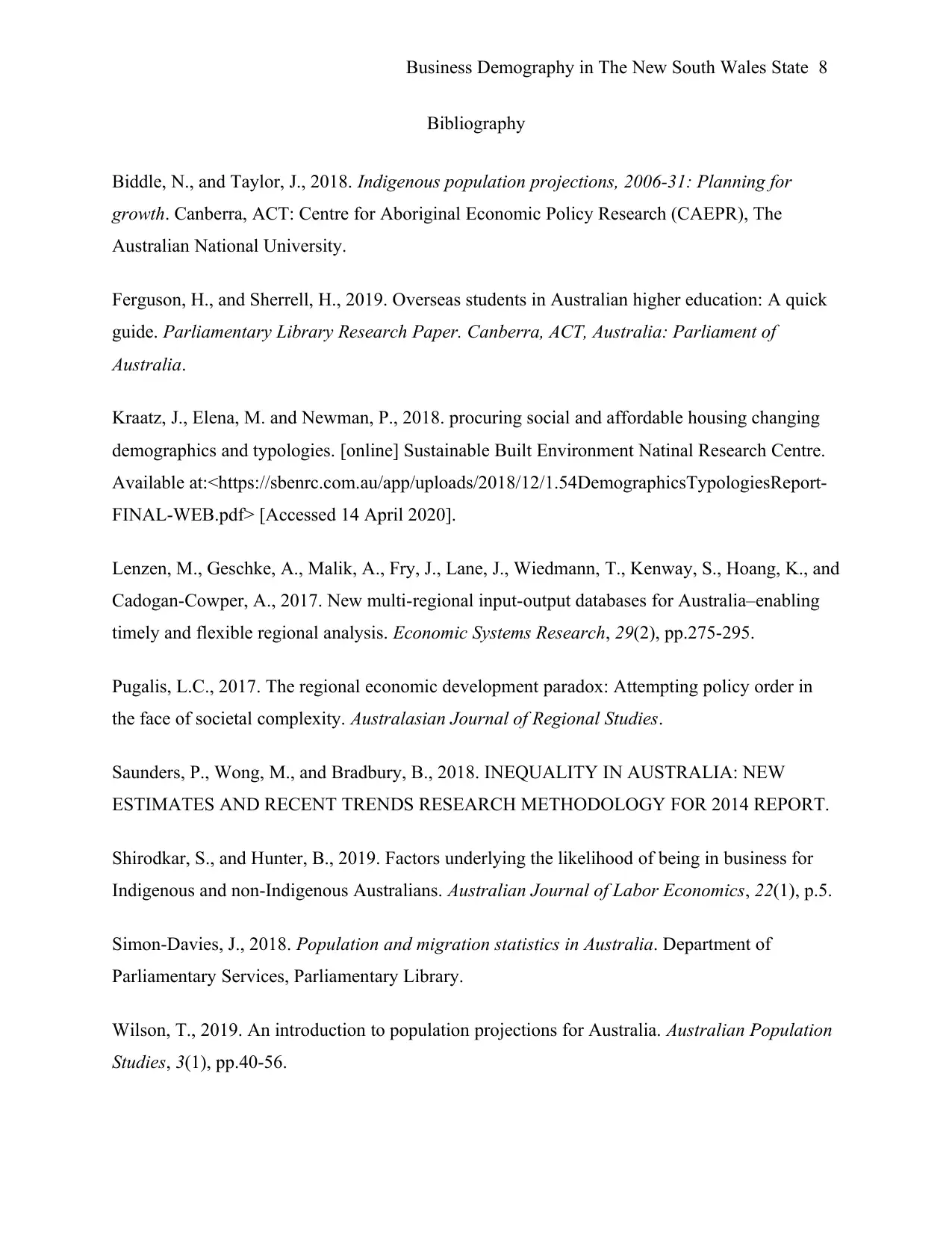
Business Demography in The New South Wales State 8
Bibliography
Biddle, N., and Taylor, J., 2018. Indigenous population projections, 2006-31: Planning for
growth. Canberra, ACT: Centre for Aboriginal Economic Policy Research (CAEPR), The
Australian National University.
Ferguson, H., and Sherrell, H., 2019. Overseas students in Australian higher education: A quick
guide. Parliamentary Library Research Paper. Canberra, ACT, Australia: Parliament of
Australia.
Kraatz, J., Elena, M. and Newman, P., 2018. procuring social and affordable housing changing
demographics and typologies. [online] Sustainable Built Environment Natinal Research Centre.
Available at:<https://sbenrc.com.au/app/uploads/2018/12/1.54DemographicsTypologiesReport-
FINAL-WEB.pdf> [Accessed 14 April 2020].
Lenzen, M., Geschke, A., Malik, A., Fry, J., Lane, J., Wiedmann, T., Kenway, S., Hoang, K., and
Cadogan-Cowper, A., 2017. New multi-regional input-output databases for Australia–enabling
timely and flexible regional analysis. Economic Systems Research, 29(2), pp.275-295.
Pugalis, L.C., 2017. The regional economic development paradox: Attempting policy order in
the face of societal complexity. Australasian Journal of Regional Studies.
Saunders, P., Wong, M., and Bradbury, B., 2018. INEQUALITY IN AUSTRALIA: NEW
ESTIMATES AND RECENT TRENDS RESEARCH METHODOLOGY FOR 2014 REPORT.
Shirodkar, S., and Hunter, B., 2019. Factors underlying the likelihood of being in business for
Indigenous and non-Indigenous Australians. Australian Journal of Labor Economics, 22(1), p.5.
Simon-Davies, J., 2018. Population and migration statistics in Australia. Department of
Parliamentary Services, Parliamentary Library.
Wilson, T., 2019. An introduction to population projections for Australia. Australian Population
Studies, 3(1), pp.40-56.
Bibliography
Biddle, N., and Taylor, J., 2018. Indigenous population projections, 2006-31: Planning for
growth. Canberra, ACT: Centre for Aboriginal Economic Policy Research (CAEPR), The
Australian National University.
Ferguson, H., and Sherrell, H., 2019. Overseas students in Australian higher education: A quick
guide. Parliamentary Library Research Paper. Canberra, ACT, Australia: Parliament of
Australia.
Kraatz, J., Elena, M. and Newman, P., 2018. procuring social and affordable housing changing
demographics and typologies. [online] Sustainable Built Environment Natinal Research Centre.
Available at:<https://sbenrc.com.au/app/uploads/2018/12/1.54DemographicsTypologiesReport-
FINAL-WEB.pdf> [Accessed 14 April 2020].
Lenzen, M., Geschke, A., Malik, A., Fry, J., Lane, J., Wiedmann, T., Kenway, S., Hoang, K., and
Cadogan-Cowper, A., 2017. New multi-regional input-output databases for Australia–enabling
timely and flexible regional analysis. Economic Systems Research, 29(2), pp.275-295.
Pugalis, L.C., 2017. The regional economic development paradox: Attempting policy order in
the face of societal complexity. Australasian Journal of Regional Studies.
Saunders, P., Wong, M., and Bradbury, B., 2018. INEQUALITY IN AUSTRALIA: NEW
ESTIMATES AND RECENT TRENDS RESEARCH METHODOLOGY FOR 2014 REPORT.
Shirodkar, S., and Hunter, B., 2019. Factors underlying the likelihood of being in business for
Indigenous and non-Indigenous Australians. Australian Journal of Labor Economics, 22(1), p.5.
Simon-Davies, J., 2018. Population and migration statistics in Australia. Department of
Parliamentary Services, Parliamentary Library.
Wilson, T., 2019. An introduction to population projections for Australia. Australian Population
Studies, 3(1), pp.40-56.
1 out of 8
Related Documents
Your All-in-One AI-Powered Toolkit for Academic Success.
+13062052269
info@desklib.com
Available 24*7 on WhatsApp / Email
![[object Object]](/_next/static/media/star-bottom.7253800d.svg)
Unlock your academic potential
Copyright © 2020–2025 A2Z Services. All Rights Reserved. Developed and managed by ZUCOL.





